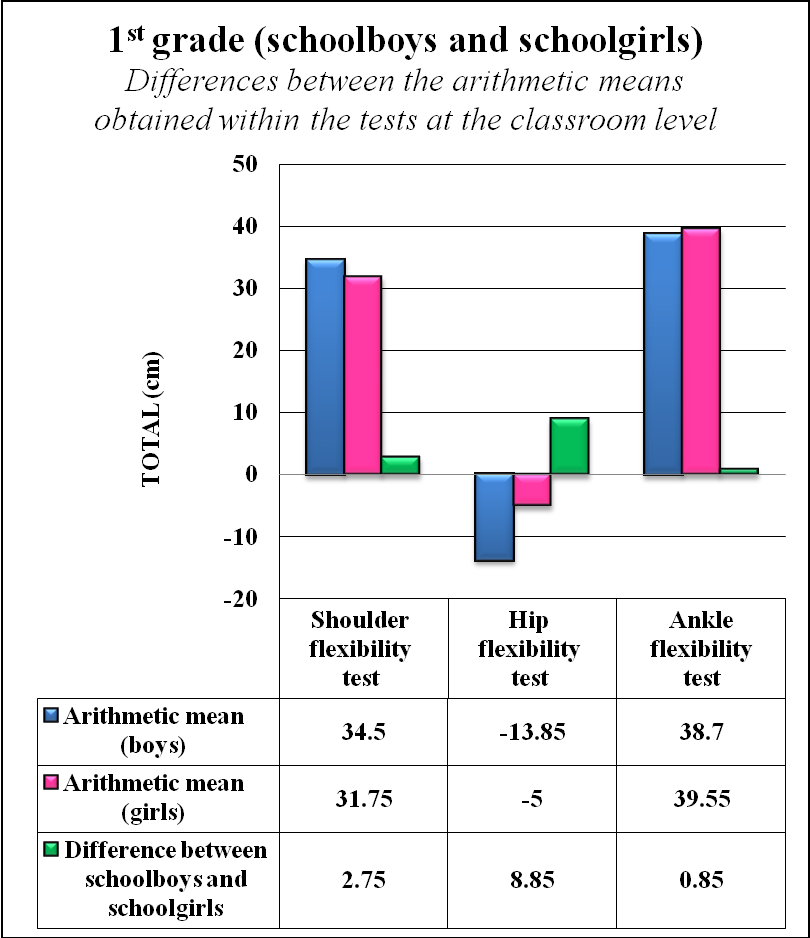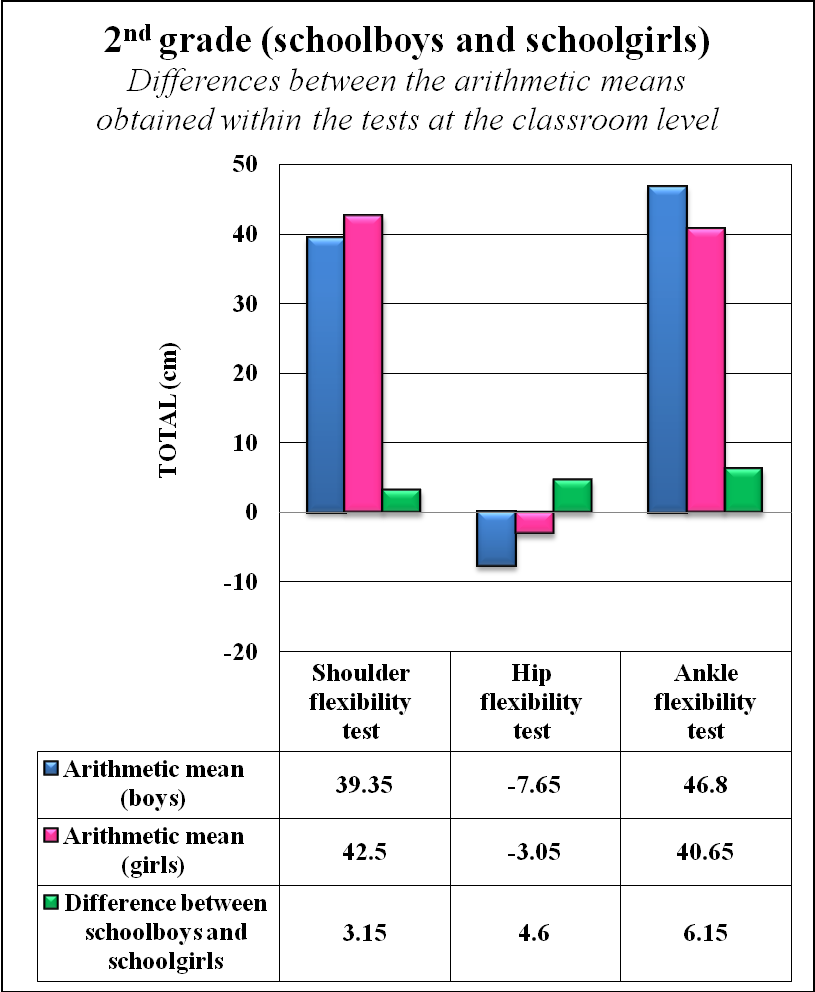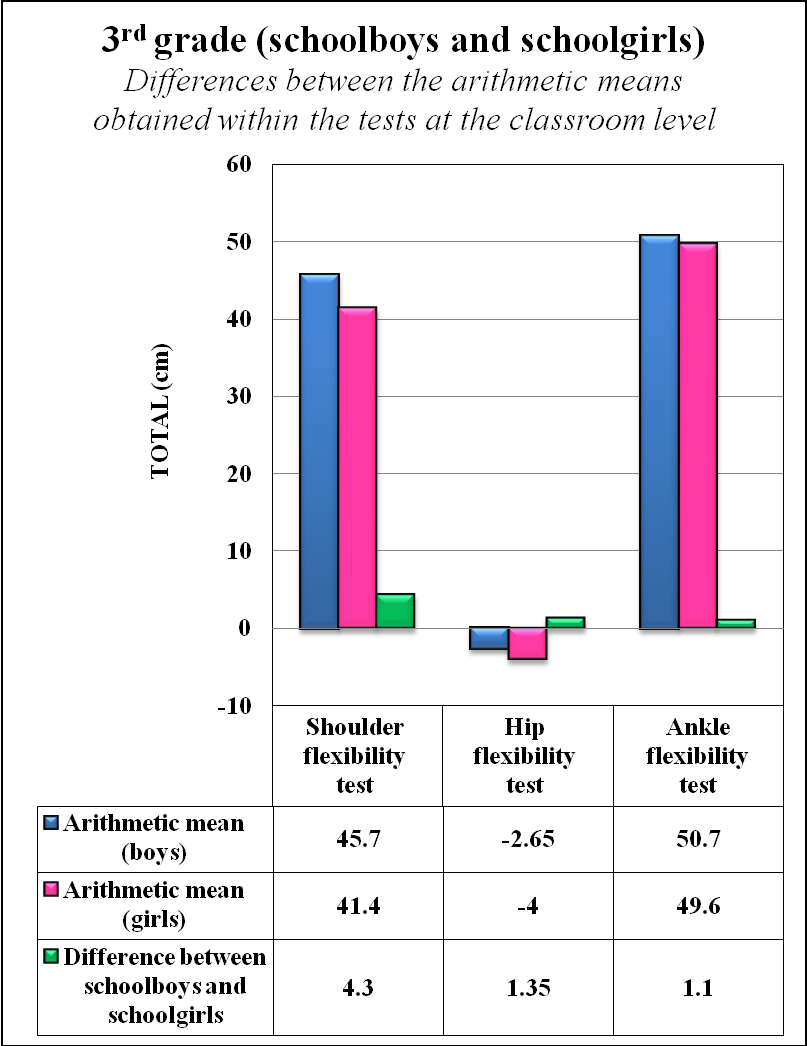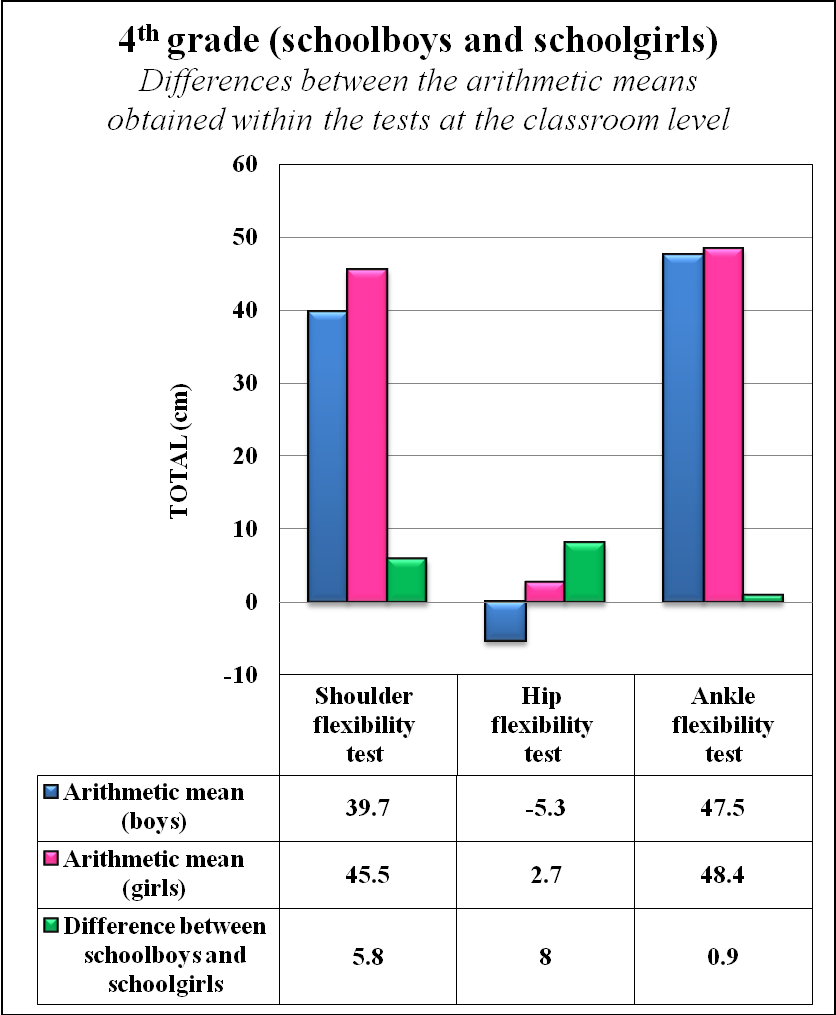Abstract
The role of physical education is to act in order to increase the manifestation of motor ability indices among pupils. For this reason, the development of joint mobility in young pupils has a particular importance, by its limiting effects on the adjustments and designation of the movement easiness characterizing the ability of an element to move. The purpose of this paper was to make a diagnosis of the range of motion for the main joints, which included measurements of mobility in the scapular-humeral, coxofemoral and talocrural joints, in primary school pupils from Middle School No. 192. To achieve the intended purpose, it was initiated a comparative study conducted between December 2014 and January 2015, during 14 lessons (according to school schedule and curriculum). The subjects were 80 pupils from 1st to 4th grades, participants in the physical education and sports lesson. It was created a group of schoolboys and also a group of schoolgirls for each grade of the primary education, in total 4 groups of 10 schoolboys each and 4 groups of 10 schoolgirls each. Results were obtained using tests for the mobility or flexibility assessment, according to Brian Mackenzie, and through the statistical method, we calculated the arithmetic mean. Analysis of the results provides objective information about the level of mobility development in the subjects tested throughout their evolution.
Keywords: Joint mobility, evolution, primary school level
Introduction
Primary education represents a defining stage in building the child’s personality, under the
perspective of his/her subsequent becoming and social-cultural integration (Golu, 2010: 156).
Physical education is assigned the role of harmonizing and creating a balance between intellectual
and psychomotor demands, in order to ensure physical development and movement ability of the pupils
(Programa şcolară pentru educaţie fizică - clasa pregătitoare, clasa I şi clasa a II-a, 2013). School environment provides the child aged 6 to 10/11 years opportunities of social integration,
with large resonances on the biological and psychological planes, accumulations being facilitated by
the growth and development particularities at these ages (Dragnea & Bota, 1999: 136; Golu, 2010: 14).
Motor conducts acquired in the first school years mainly aim to lay the basis of general motricity, a
fundamental aspect for ensuring the individual’s adaptation to complex life situations. The level of
motricity development is expressed by the child’s motor ability, through stable components that make
reference to aptitudes, skills, motor qualities, knowledge, experiences, and state-related components
regarding motivational, affective, volitional aspects (Dragnea & Bota, 1999: 41).
In the physical education lesson, one of the main objectives is the development of motor qualities,
simultaneously with the formation of motor abilities and skills (Grigore & Dinţică, 2010: 5), and one of
the motor qualities that can be fully developed at this age level is the joint mobility (Manno, 1992:
167). We agree to this view, although data from specialized literature place the maximal influence
towards older ages, after 10 years old (Famose & Durand, 1988: 103; Weineck, 1994: 254). In this
regard, we underline the information provided by the field of rhythmic gymnastics, where the joint
mobility is essential for practicing this discipline. Authors such as Jastrejevskaya (1995: 539) consider
that the optimal age is 6 to 13 years, asserting that, after this period, accumulations may suddenly
decrease if there are not taken the necessary steps to maintain the training state.
In specialized literature, descriptions referring to the evolution of different motor qualities at these
ages mention the qualitative improvements in muscle contraction and motor control, reflected by the
manifestations of strength, speed and motor coordination (Epuran & Stănescu, 2010: 190; Dragnea &
Bota, 1999: 136). We notice however the lack of references about the manifestation of mobility.
The scarce information about the joint mobility, as compared to the extremely great number of
research studies about the other motor qualities, is also highlighted by several authors (Macovei, 1999:
8; Knudson, Magnusson, & McHugh, 2000).
There are papers approaching the joint mobility manifestation in relation with different stretching
techniques, but they are usually addressed to adult persons and performance athletes (Feland, Myrer, &
Merrill, 2001; Schuback, Hooper, & Salisbury, 2004; Yuktasir & Kaya, 2009; Puentedura et al.; 2011).
For the age level from 6 to 10 years, the authors’ interest was focused on the girl athletes too, the
joint mobility implications being decisive for certain sports disciplines (Bitang, 2008).
Some data referring to the joint mobility can be found in studies on the biomotor potential of pupils,
but the latest one was achieved in 1992 (Paraschiv & Sintie, 1992: 101-112).
In the context of the above-mentioned aspects, we have in view that mobility should be permanently
developed, particularly at those ages where the muscle and ligament structures show increased
plasticity. In the young pupil, performing range of motions in various joints is conditioned by the low
level of muscle tone and muscle mass, which leads us to take into consideration these issues, too
(Dragnea & Bota, 1999: 136-138; Cârstea, 1993: 64).
1.1. Purpose
The purpose of this paper is to make a diagnosis regarding the joint mobility values in the young
pupil and their evolution according to the subjects’ age and gender. This study represents the beginning of a longitudinal research, which aims to establish some
coordinates in the evolution of indices related to joint mobility and also the methods suitable to its
development in pupils at the primary education level.
Materials and methods
The research was conducted in the period from December 2014 to January 2015, within Middle
School No. 192.
The subjects were 80 pupils from 1st to 4th grades, participants in the physical education and sports
lesson. It was created a group of schoolboys and also a group of schoolgirls for each grade of the
primary education, in total 4 groups of 10 schoolboys each and 4 groups of 10 schoolgirls each.
To achieve this study, the following methods were used: theoretical documentation, observation,
testing method, statistical method and graphical representation method.
The subjects’ mobility/flexibility was investigated at the level of scapular-humeral, coxofemoral and
talocrural joints. The applied tests were: shoulder and wrist flexibility test (Mackenzie, 2005: 85), hip
flexibility test (Mackenzie, 2005: 81) and ankle flexibility test (Mackenzie, 2005: 79).
Shoulder and wrist flexibility test: from prone position, with forehead on the floor and arms
extended upwards, holding the gym stick at the shoulder width. The subject must raise the stick as high
as possible, keeping the forehead on the floor during testing. It is measured the vertical distance
between floor and stick. Required resources: gym stick and measuring tape.
Hip flexibility test: from sit on the floor position, with arms close to the body. The subject must lean
the trunk forward without knee flexion, trying to reach tiptoes with the fingers, while keeping the chin
to chest. It is measured the distance between fingertips and tiptoes. Values are negative if tiptoes are
not reached, and become positive if their level is exceeded in depth. Required resources: gym bench
and measuring tape.
Ankle flexibility test: from stand position facing a wall, with arms raised up, the entire body
touching the wall. The subject must slowly slide the feet back from the wall as far as possible, keeping
the chest in contact with the wall and the feet flat on the floor. It is measured the distance between wall
and the toe line. Required resources: non-slippery floor, stable wall and measuring tape.
We have opted for these tests because they are easy to use in the physical education lesson, and
measurement is unitary, in centimetres.
Results
The results, which have been assessed in their evolution at the classroom level, show increased
values for all joints, in both genders. Generally speaking, the statistical indicators presented in Table 1
reveal minor differences between male and female subjects, but the girls, as expected, have slightly
better values. For the shoulder and ankle joints, there have been found improvements since the 1st grade
towards the 2nd and 3rd grades, and a slight decrease in the 4th grade pupils.
Analysis of the results achieved by the 1st grade pupils shows that boys have better values than girls
for the shoulder joint and approximately identical values for the ankles. But at the hip level, boys have
modest results (-13.85), with a difference of 8.85 in favour of the girls, which indicates that the
mobility development has not been stressed at this level.

In the 2nd grade, for the hip joint, the previously commented trend existing in the case of 1st grade
pupils is still maintained. Figure 2 shows that, for the ankle joint, boys have a plus of 6.15 cm (46.8
cm) compared to the girls (40.65 cm), however the girls exceed the boys at the shoulder level by 3.15
cm (39.35 cm boys and 42.5 cm girls). For the hip, values have improved and got closer, but there is
still a difference of 4.6 cm.

In Figure 3, for the indices achieved by the 3rd grade pupils, it is noted an increase for both groups
of subjects, as well as closer mean values, with differences of 4.3 in favour of the boys for the shoulder
joint and 1.1 cm for the ankle. As to the hip, it is recorded the smallest difference between boys and
girls from all classrooms (1.35 cm).

Gender-related differences in the 4th grade pupils show that girls have better results for all joints and
there are noticed, for the first time, positive values in the hip joint (Fig. 4).

Discussions and conclusions
The mean values identified for each class of pupils, as well as the overall mean of tests for each
joint, shown in Table 1, can be considered a current profile of the group of subjects. Driven by the
desire to relate to the literature data, in order to see where these values are placed, we underline that we
have not found scales for this age level. The reason also resides in the test typology.
But we can make references to some normative data regarding the shoulder flexibility test,
recommended by Mackenzie (2005: 86). Although these ones are established for older pupils, we find
out that our subjects - mean 39.81 cm boys and 40.28 cm girls - fall within the “exceptional” category
(standard data for “exceptional” >31.8 cm boys and >29.8 cm girls). We estimate that the results could
be associated to our introductive discussions, where we highlight that the mobility values decrease with
age if not maintained through constant interventions.
For the ankle joint, normative data recommended by the same author (Mackenzie, 2005: 79) frame
our groups of subjects within the “poor” level. But we consider that this situation is due to the
differences in height between younger pupils and older pupils, the way of achieving the measurement
being influenced by the tested subject’s height. Under this aspect, we estimate that the flexion angle
measurement would be more objective.
As regards the differences noticed between female and male subjects, we emphasize the girls’
permanently better level in the hip joint mobility. We consider that this situation might also be due to
their concerns for gymnastics and dance activities, unlike the boys, who are mainly oriented towards
exercises that do not exert their mobility at this level. Relating to the scales identified in literature, we
find out that the values obtained by our subjects are rated “satisfactory” and only the 4th grade girls can
be rated “good” (Tudor, 2013: 155).
The obtained results provide objective data about the mobility development level in the tested
subjects and the evolution graph for each grade of primary education.
We think that the evolution of values depends on the growth and development particularities of
young pupils, but also on the pedagogical intervention during the motor activities in which they are
involved.
The study results generally depict the particularity of the joint mobility manifestation at the primary
level within Middle School No. 192. By the achieved diagnosis, it has been created a database that will
be used in our further research. We refer to the fact that, at the subsequent testing, we shall have
available reference data to which we can relate.
Acknowledgements
Our thanks to the leaders of Middle School No. 192, the women teachers and the pupils who agreed
to participate in the testing.
References
Bitang, V. (2008). Studiul mobilităţii articulare la copii înotători. Conferinţa ştiinţifică naţională în domeniul ştiinţei sportului, “Valorificarea cercetării ştiinţifice în domeniul activităţilor corporale” (pp. 67-71). Bucureşti: CSSR & INCS.
Cârstea, Gh. (1993). Contribuţii la ameliorarea metodologiei procesului de educaţie fizică şi sportivă şcolară în condiţiile unor activităţi autonome ale elevilor şi profesorului (Teză de doctorat). ANEFS, Bucureşti.
Dragnea, A., & Bota, A. (1999). Teoria activităţilor motrice. Bucureşti: Editura Didactică şi Pedagogică.
Epuran, M., & Stănescu, M. (2010). Învăţarea motrică - aplicaţii în activităţile corporale. Bucureşti: Discobolul.
Famose, J. P., & Durand, M. (1988). Aptitude et performance motrice. Paris: Revue EPS.
Feland, J. B., Myrer, J. W., & Merrill, R. M. (2001). Acute changes in hamstring flexibility: PNF versus static stretch in senior athletes. Physical Therapy in Sport, 2(4), 186-193.
Golu, F. (2010). Psihologia dezvoltării umane. Bucureşti: Editura Universitară.
Grigore, Gh., & Dinţică, G. (2010). Metodica dezvoltării calităţilor motrice la copiii de 7-11 ani. Bucureşti: Discobolul.
Jastrejevskaya, N. (1995). Rhythmic Sportive Gymnastics. Theory and Practice. [Copyright FIG].
Knudson, D. V., Magnusson, P., & McHugh, M. (2000). Current Issues in Flexibility Fitness. Retrieved from http://eric.ed. gov/?id=ED448119 Mackenzie, B. (2005). 101 Performance Evaluation Tests. London: Electric Word. Retrieved from http://www.pponline.co.uk/101Evaluations/pdfs/101EvaluationTests.pdf Macovei, S. (1999). Supleţea. Bucureşti: ANEFS.
Manno, R. (1992). Les bases de l’entraînement sportif. Paris: Revue EPS.
Paraschiv, V., & Sintie, A.-M. (1992). Studiu comparativ al potenţialului biomotric al elevilor din clasele I-IV la a treia ediţie a evaluării. [Sub egida Ministerului Tineretului şi Sportului, Centrul de cercetare pentru Problemele Sportului, Ministerul Învăţământului şi Știinţei]. Bucureşti.
Programa şcolară pentru educaţie fizică - clasa pregătitoare, clasa I şi clasa a II-a. (2013). Bucureşti: MEN.
Retrieved from http://programe.ise.ro/Portals/1/2013_CP_I_II/54_Educatie%20fizica_CP_II_OMEN.pdf Puentedura, J. E., Huijbregts, A. P., Celeste, S., & Edwards, D. (2011). Immediate effects of quantified hamstring stretching: Hold-relax proprioceptive neuromuscular facilitation versus static stretching. In M. R. Landers & C. Fernandez-de-las-Penas, Physical Therapy in Sport, 12(3), 122-126.
Schuback, B., Hooper, J., & Salisbury, L. (2004). A comparison of a self-stretch incorporating proprioceptive neuromuscular facilitation components and a therapist-applied PNF-technique on hamstring flexibility. Physiotherapy, 90(3), 151-157.
Tudor, V. (2013). Măsurare şi evaluare în sport. Bucureşti: Discobolul.
Weineck, J. (1994). Entrenamento optimo. Barcelona: Hispano Europeea S.A.
Yuktasir, B., & Kaya, F. (2009). Investigation into the long-term effects of static and PNF stretching exercises on range of motion and jump performance. Journal of Bodywork and Movement Therapies, 13(1), 11-21.
Copyright information

This work is licensed under a Creative Commons Attribution-NonCommercial-NoDerivatives 4.0 International License.
About this article
Publication Date
10 June 2016
Article Doi
eBook ISBN
978-1-80296-010-5
Publisher
Future Academy
Volume
11
Print ISBN (optional)
-
Edition Number
1st Edition
Pages
1-509
Subjects
Sports, sport science, physical education
Cite this article as:
Ciocioi, A., & Macovei, S. (2016). Study about the Evolution of Joint Mobility in Pupils at the Primary School Level. In V. Grigore, M. Stanescu, & M. Paunescu (Eds.), Physical Education, Sport and Kinetotherapy - ICPESK 2015, vol 11. European Proceedings of Social and Behavioural Sciences (pp. 54-60). Future Academy. https://doi.org/10.15405/epsbs.2016.06.8

